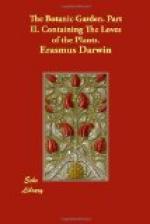[Illustration: Dionna Muscipula]
[Illustration: Amaryllis formosissima]
The
harlot-band ten lofty bravoes screen,
And
frowning guard the magic nets unseen.—
Haste,
glittering nations, tenants of the air,
Oh,
steer from hence your viewless course afar!
145 If with soft words, sweet blushes, nods, and
smiles,
The
three dread Syrens lure you to their toils,
Limed
by their art in vain you point your stings,
In
vain the efforts of your whirring wings!—
Go,
seek your gilded mates and infant hives,
150 Nor taste the honey purchas’d with your
lives!
When
heaven’s high vault condensing clouds deform,
Fair
AMARYLLIS flies the incumbent storm,
[Amaryllis, l. 152. Formosissima. Most beautiful Amaryllis. Six males, one female. Some of the bell-flowers close their apertures at night, or in rainy or cold weather, as the convolvulus, and thus protect their included stamens and pistils. Other bell-flowers hang their apertures downwards, as many of the lilies; in those the pistil, when at maturity, is longer than the stamens; and by this pendant attitude of the bell, when the anthers burst, their dust falls on the stigma: and these are at the same time sheltered as with an umbrella from rain and dews. But, as a free exposure to the air is necessary for their fecundation, the style and filaments in many of these flowers continue to grow longer after the bell is open, and hang down below its rim. In others, as in the martagon, the bell is deeply divided, and the divisions are reflected upwards, that they may not prevent the access of air, and at the same time afford some shelter from perpendicular rain or dew. Other bell-flowers, as the hemerocallis and amaryllis, have their bells nodding only, as it were, or hanging obliquely toward the horizon; which, as their stems are slender, turn like a weathercock from the wind; and thus very effectually preserve their inclosed stamens and anthers from the rain and cold. Many of these flowers, both before and after their season of fecundation, erect their heads perpendicular to the horizon, like the Meadia, which cannot be explained from meer mechanism.




